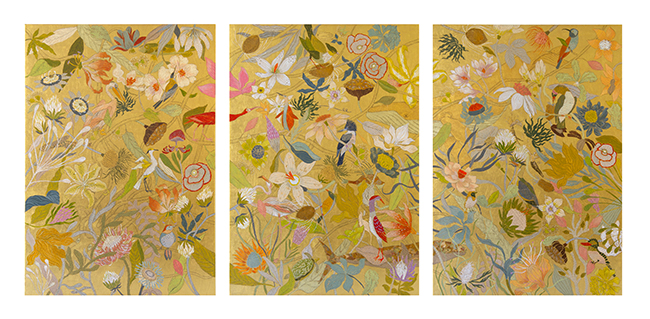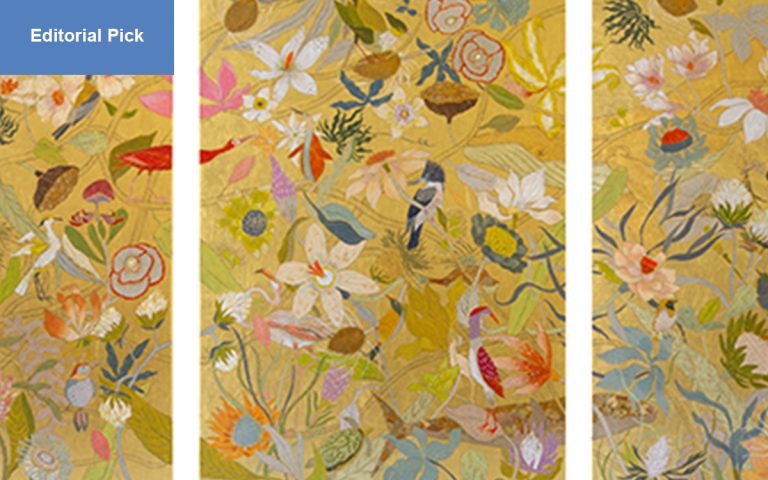Sigrid Thaler is an Italian artist whose life has unfolded across continents and cultures. Now based in Milan, her path began in a small mountain town in northern Italy. That environment — quiet, raw, and grounded in nature — left an early mark on her creative approach. Over time, her work has taken on new layers through years spent living in Austria, Paris, Singapore, and São Paulo. Each city added its own rhythm to her visual language. Along the way, she absorbed influences from Nordic simplicity to Southeast Asian vibrancy. These varied perspectives now coexist in her art, forming a body of work that feels both rooted and fluid. While her materials and methods evolve, the thread connecting her practice is a search for harmony — between the natural world and the abstract, between sound and sight, between stillness and movement.
Her 2025 piece Sinfonia is a clear example of this pursuit.

The work is a triptych — three panels standing together as one. Measuring 83 by 39 inches, it’s large enough to surround the viewer, almost like a stage set or the backdrop of an imagined world. The first thing that catches the eye is the shimmer. Thaler uses 22-karat gold leaf, along with other grades of gold, layered with acrylic paint. The result is a surface that shifts with the light — sometimes glowing, sometimes subdued, never static.
The title Sinfonia was carefully chosen. Thaler compares her process to writing a musical composition, where each panel acts like a movement, and the visual elements are notes. Shapes and textures repeat and respond to each other across the panels, creating a sense of flow. There’s no rigid symmetry — instead, it’s closer to improvisation, or what she calls “a hymn to life.”
Music plays a direct role in how she paints. While working on Sinfonia, Thaler listened to a range of compositions — from traditional Indian ragas to minimalist piano scores. She doesn’t try to illustrate music literally. Instead, she lets it shape the mood of her gestures, the layering of color, the pacing of detail. The result is visual, but with echoes of sound embedded in the rhythm of brushstrokes.
Cultural influence is another layer. Thaler has long been drawn to Japanese aesthetics — particularly the idea of asymmetry, negative space, and refinement of detail. That influence shows in her use of restraint. Even in a painting filled with gold, there are quiet zones — areas that invite pause, not spectacle. More recently, Indian visual culture has inspired her, especially in its relationship to nature. In Sinfonia, this influence appears in the stylization of organic forms — leaves, waves, and fluid lines that seem both ornamental and elemental.
There’s also a tactile quality to her work. The gold leaf is not flatly applied. It wrinkles, catches, and sometimes cracks. These surface imperfections are not flaws but part of the piece’s life. For Thaler, the material’s aging process is as meaningful as its initial luster. She lets the elements — light, air, time — continue shaping the work after it’s finished.
While Sinfonia feels expansive and abstract, it’s also deeply personal. Thaler sees the piece as a kind of self-portrait — not in terms of likeness, but as a reflection of her internal landscape. It’s informed by places she’s lived, music she’s absorbed, and the emotional undercurrents of her daily life. Yet, she avoids locking the viewer into her interpretation. Instead, she offers an open structure — one that invites reflection and movement.
In many ways, Sinfonia feels like a crossroads — of technique, memory, and motion. It’s not trying to make a grand statement. Instead, it quietly pulses with attention, care, and curiosity. The work doesn’t try to pin down a single message. Like a symphony, it unfolds in time, in layers, offering different things with each encounter.
Thaler’s art isn’t about dramatic reinvention. It’s about steady progress — collecting moments, building textures, and letting them breathe. With Sinfonia, she brings together the languages of gold, paint, sound, and silence to create something that doesn’t just hang on a wall — it resonates.

